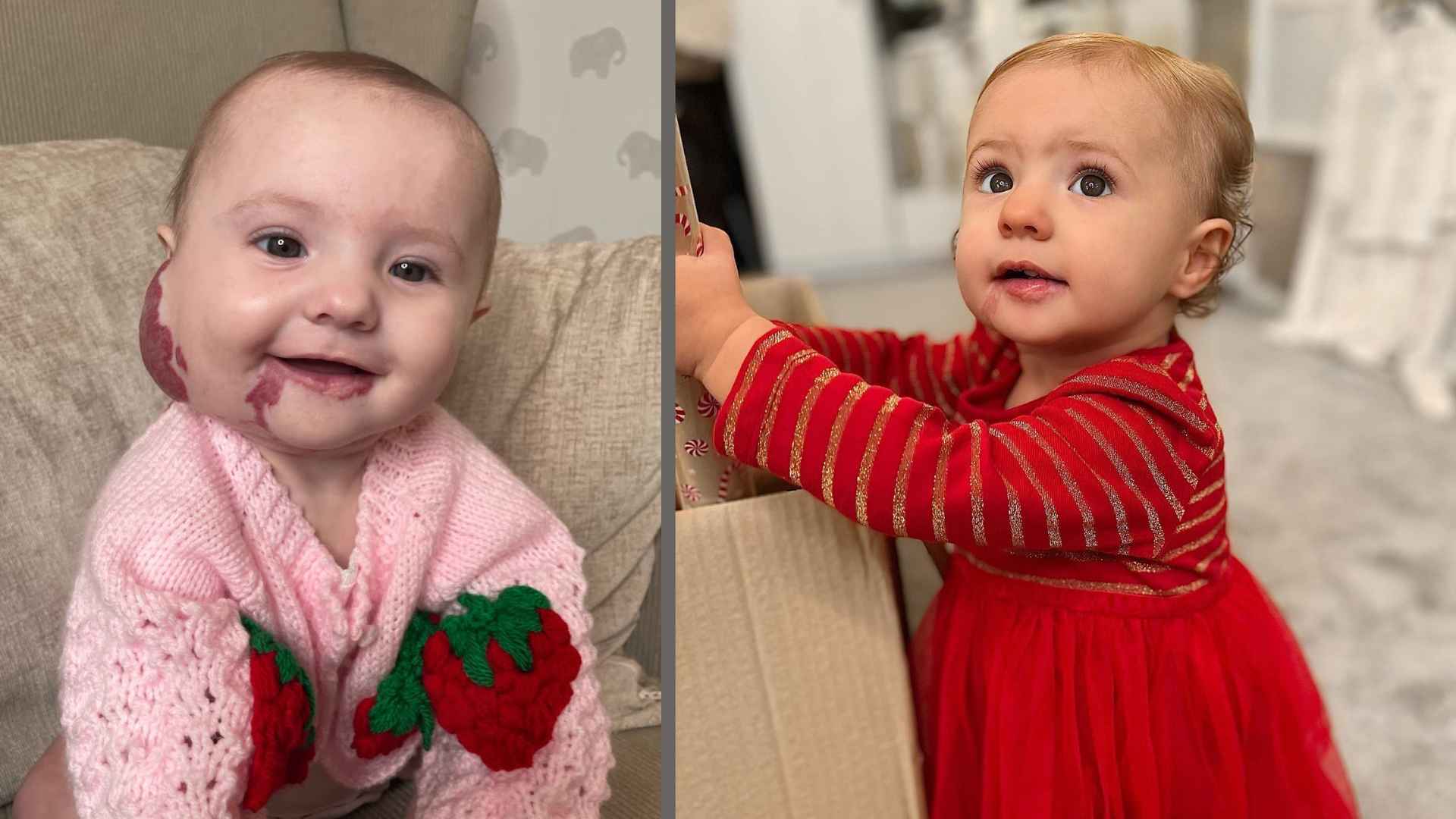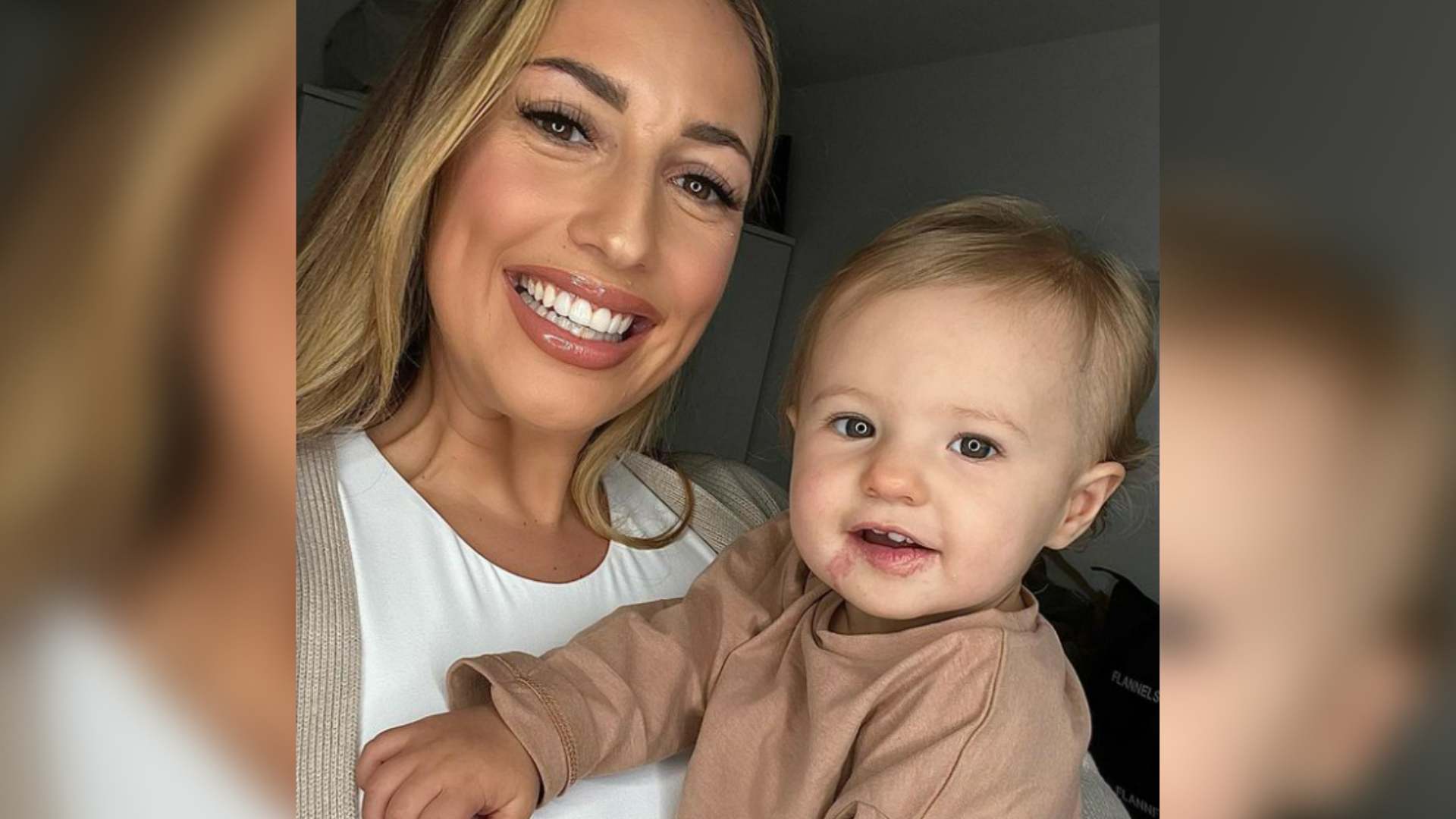My daughter Lola was born last September. In the few days after she was born, we started to notice some redness around her ear and chin, and under her neck.
At first, during midwife visits and routine check-ups, we were told not to worry – she’d just been born and a lot of babies got little marks after birth.
It was after we’d been signed off by our midwife that things started to progress. We started to notice the marks getting really red. Then, the marks around her ear started to swell. We took her to the GP, who weren’t overly concerned and said that it was possibly a haemangioma, also known as a strawberry mark. But I was concerned – I’d never even heard of a strawberry mark.
Soon, the swelling and marks on her ear became so large that we ended up taking Lola to A&E over the course of a weekend. COVID-19 was still extremely prominent and hospitals were busy, with one carer rules, but we could no longer see the inside of her ear. Her whole face was just so swollen.
Dealing with other people’s reactions to Lola’s strawberry mark has been tough at times.
We got admitted to hospital and Lola got seen to by lots of different specialists and started on medication. Since then, over the past year, she’s been under the care of a paediatrician who is a specialist in haemangiomas. She’s been seen by an array of experts – including ear nose and throat specialists who keep track of her progress. The medication is stopping her ear from becoming disfigured and has healed the ulcerations on her lips that stopped her from feeding. It’s working well – but it’s not been a fast process and we definitely didn’t see results overnight.
Curiosity can hurt
Dealing with other people’s reactions to Lola’s strawberry mark has been tough at times. My fiancée, Tom, is good at not being fussed about it. But when we weren’t sure what her strawberry marks were, I would find it hard to offer explanations to people who stared or made comments about her appearance.
We went on holiday at the beginning of last year and by the end of the week, I just wanted to come home. The constant stares and double-takes got to me. After a week of being out in public, dealing with the negativity without our friends and family to support, it became hard work.
On the night flight home, a flight attendant came running over, in alarm, crying “madam, madam! Your baby, she’s bleeding!” At first, I panicked and felt an instinctive rush of adrenaline, before staring into sleeping Lola’s direction and realising he was concerned about her birthmark. When it clicked for him, he was so apologetic.

The life of Lola, online
One of the most positive things about having a daughter with a visible difference, is the community I’ve found online. I really don’t know what I’d have done without social media.
When I first heard about strawberry marks, I just kept searching for answers on google and on social media. In the early days, when Lola’s strawberry was growing, I was looking for another person who had gone through what I was going through – to offer advice on what to do, where to go, how to get help. As her marks got bigger and redder, I was looking for photos of other babies and thinking – does anybody else look like this? On Instagram, I was searching strawberry mark hashtags several times a day – and only found a few accounts to offer support. These accounts helped – and I’m still in contact with them. But I was surprised at how little was out there, to the point where I’d thought I’d got the name of her condition wrong.
The doctors told me that strawberry marks were common, that one in 20 babies are born with them. Although this felt reassuring, in the early days, I would find myself searching around town and in supermarkets, looking for another baby that looked like Lola. With so many of my friends having babies and children, too, I just couldn’t believe that the statistic was accurate after not seeing another baby with one apart from Lola.
The more I learnt about Lola’s condition, the more confident I felt talking about it.
Eventually, I decided to become the representation I was looking for. I set up an Instagram page for Lola and a #ShowOffYourStrawberry hashtag to encourage others to represent the strawberry community. I soon started to connect with people like me – who all told me that they too had been looking for accounts that featured babies and children with strawberry birthmarks. There seemed to be so many people out there that wanted to see a baby or child like theirs. The DMs started to come in waves, with parents sharing pictures and saying “my baby’s got a mark like Lola’s,” or people who wanted advice from my experiences, or people further along the journey – saying things like: “my daughter is 30 and had a strawberry birthmark when she was younger – it’s all going to be ok.” – Music to my ears!
My Instagram page “The Life of Lola” grew rapidly – gaining 20,000 followers in a couple of months. It’s helped me as much as it helps other people. The people I’m connecting with are from all over the world. Without this community, there’s no way I’d believe the doctor’s statistic about how common strawberry birthmarks are.
Now, when I go out and about, I know that Lola looks different to other babies. But when I get home, and open up the Instagram app, I feel like I belong. I’m part of this group who understands, and I’m in a community of people and we’re all the same. It’s been a lifesaver, really.
The rough with the smooth
Unfortunately, having a large following on social media has meant that I’ve had quite a few trolls on Instagram, too. Only a tiny, tiny percentage compared to lots of lovely comments on our posts, so it’s nothing I can’t handle. When her birthmark was more prominent, I had comments saying that it was blood, that I’d hit her, and other things like “she’s not beautiful,” and “get the tumour removed”.
Now the birthmark has shrunk and is less red in colour, I notice there’s less staring and less negative comments. It’s ridiculous – nobody should have to deal with judgement and negativity, no matter how visible the difference is.
Lola’s strawberry just looks like a birthmark, now, and I think that the negative comments we had before were due to a lack of understanding. It seems that people just couldn’t believe it was a birthmark. Through lack of understanding, ignorance would emerge and make its way through. It’s why representation of visible difference is so important.
It’s exhausting dealing with other people’s reactions to your child’s visible difference, so reach out to Changing Faces for support.
Rudeness is never acceptable, but it will always exist. Educating people so that they understand helped me when I was experiencing lots of questions and stares. The more I learnt about Lola’s condition, the more confident I felt talking about it. I stopped feeling uneasy when someone stared and loved taking the opportunity to say: “it’s a birthmark”.
But you can’t always do that when walking down the street or sitting in a restaurant. That’s why representation really is important. The more people see visible differences in the media, on tv or in advertising, the less they’ll stare or behave negatively towards people who look different. I absolutely love working with brands who are already prioritising representation – including Jojo Bebe Maman, who supported me to do a takeover on their social media, from one of their stores on Vascular Birthmark Awareness Day in May.
For parents anxious about their child’s birthmark…
Trust your instincts. If you’re starting to worry, keep asking for second opinions. Finding a community will help with this – I’ve found that parents are always willing to support one another, and many will have been through similar situations to you.
Once you’ve found your community, lean on them for support. Through the good times and bad, having people around you to understand you and lift you up is fantastic – all while celebrating your beautiful child.
Finally, reach out to Changing Faces if you need support. It’s exhausting dealing with other people’s reactions to your child’s visible difference, and negative behaviours like staring or rude comments can get you down. Their support and information line will be a great listening ear, and they can provide you with advice and tools to get you through.
